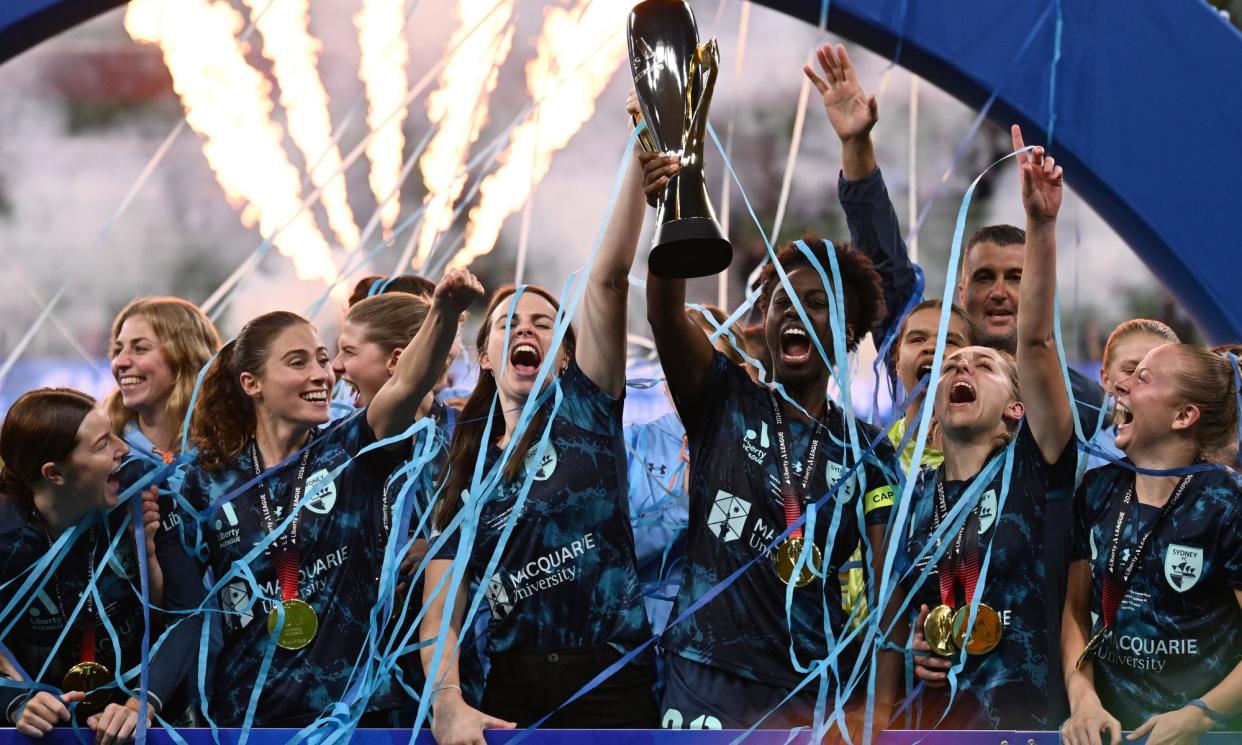Did the A-League Women manage to capitalise on the 2023 World Cup?

Was the 2023-24 A-League Women (ALW) season the best in the competition’s history? Possibly. There were certainly enough standout games, players, narrative, and intrigue to provide enough fuel to carry a long pub debate. What can be said more definitively, though, is that the campaign just concluded with Sydney FC edging Melbourne City to win a record fifth title was one of, if not the most consequential since the league’s inception.
Generally, you only get one post-World Cup season to capitalise and, after the 2023 tournament, this was the year for the ALW. And the ground was fertile. Putting aside their historic achievements on the field, what the Matildas achieved across that tournament was unprecedented, taking hearts and minds of the country in a stranglehold and altering what was thought achievable not just in women’s football, football, or sporting context, but on a cultural level itself.
The onus was on the ALW to capture some of this lightning in a bottle. Replicating what the Matildas had done was impossible – the team now occupies a plane of existence in the Australian zeitgeist closer to Taylor Swift than a footballing side – but even a little bit of that magic would make a massive difference. No pressure.
And thankfully, the league did not rest on its laurels. With the reintroduction of Central Coast, it grew to 12 teams and staged a full home-and-away season in 2023-24, becoming the first of any of Australia’s footballing codes to do so. A round one Sydney Derby set a new record for the largest ever standalone crowd for a domestic women’s game in Australia after 11,471 supporters attended. By the end of the season, the Australian Professional Leagues (APL), the league administrators, were touting the most attended season of any women’s sporting league in Australian history. Though not providing figures, the APL would boast that 2023-24 saw a 611% growth in season tickets, a 133% increase in TV hours consumed and a 108% surge in crowds.
On the pitch: Ever since the 2020 demographic shift that occurred when Sam Kerr, Steph Catley, and others departed for Europe, young talent has stepped into the limelight in the ALW, with the outbound transfer record broken thrice this season. Few young talents, however, have emerged as strikingly as the 17-year-old Melbourne City sensation Daniela Galic. Named this season’s young footballer of the year, the teenager earned her train-on place with the Matildas in February and while her club is resigned to losing her at some point – it is understood overseas clubs are already circling – they hope to get one season from her before she goes. She is a special talent.
The grand finalists Sydney and City, meanwhile, reiterated their status as the two ALW standard-bearers. The two clubs have consistently invested the necessary time and capital into growing and maintaining their women’s programmes but, crucially, this investment is fiscal and intellectual – not just putting money into the women’s side but developing proper pathways and talent identification capabilities, fostering coherent philosophies, and, especially by Sydney, engaging in proper succession planning. Their ongoing success challenges would-be foes not just to spend more but to spend consistently, and spend well.
Buuuuutttt … as ever with these matters, however, it’s not just about if progress was made – which it undoubtedly was – but how much? Say what you want about gift horses and mouths but a once-in-a-lifetime home World Cup is a gift to be treasured. Could more have been done?
“If you look at stats, memberships and everything, it’s been a very successful year,” the Matilda and Sydney attacker Cortnee Vine reflected. “I still feel like we could have done heaps more; more investment, more professionalism. There are coaches that are still not full-time. [Players are] not technically full-time.”
Indeed, the most urgent matter confronting the ALW moving forward remains increasing full-time, year-round professional opportunities for players and the coaching staff that support them. While the APL has designs on the ALW establishing itself as Asia’s premier domestic league and becoming a global destination, three in five of the league’s current player base work second jobs and all but a select few are only contracted for 35 weeks of the year.
What’s next? Ultimately, most of the challenges or handbrakes in the ALW come down to one thing: money. The Women’s World Cup was a boon for organisers but, as a private, for-profit company separate from Football Australia, the APL didn’t see a dollar. Since assuming control of the league in 2021, the APL has demonstrated a sincere commitment and ambition to growing the ALW, but a series of strategic missteps by the organisation means its perilous financial state and resulting austerity measures loom, potentially preventing it from building on what it has accomplished or forcing progress to be pared back.
Both Newcastle and Canberra’s future, for instance, came under existential threat this season after warnings from the APL it could not prop up teams amid struggles to find buyers for their licences (both team’s short-term futures now appear secure). At a time of heightened interest but, paradoxically, limited mainstream media coverage, league-produced broadcasts remain streaming only, often utilise just one or two cameras, and feature limited to no pre-, half-time, or post-game content. The league’s DubZone magazine-style show fell to cost-cutting.
“I think it will grow,” Vine reflected. “But I feel post-World Cup was the perfect time for people to be like: ‘I’m gonna invest in women’s football and see where we go.’ I’m hoping for that over the next few years.”
Get in touch
If you have any questions or comments about any of our newsletters please email moving.goalposts@theguardian.com. And a reminder that Moving the Goalposts runs twice-weekly, each Tuesday and Thursday.
This is an extract from our free weekly email, Moving the Goalposts. To get the full edition visit this page and follow the instructions.


